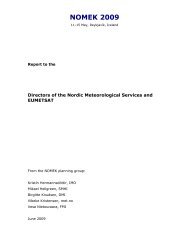International Symposium on Mitigative Measures against Snow ...
International Symposium on Mitigative Measures against Snow ...
International Symposium on Mitigative Measures against Snow ...
You also want an ePaper? Increase the reach of your titles
YUMPU automatically turns print PDFs into web optimized ePapers that Google loves.
<str<strong>on</strong>g>Internati<strong>on</strong>al</str<strong>on</strong>g> <str<strong>on</strong>g>Symposium</str<strong>on</strong>g> <strong>on</strong> <strong>Mitigative</strong> <strong>Measures</strong> <strong>against</strong> <strong>Snow</strong> Avalanches<br />
Egilsstaðir, Iceland, March 11–14, 2008<br />
Avalanche protecti<strong>on</strong> in Austria − present stage and future<br />
development<br />
Siegfried Sauermoser<br />
Austrian Service in Torrent and Avalanche C<strong>on</strong>trol, 6020 Innsbruck, Liebeneggstrasse 11, AUSTRIA<br />
e-mail: siegfried.sauermoser (at) die-wildbach.at<br />
ABSTRACT<br />
Protecti<strong>on</strong> <strong>against</strong> natural hazards such as debris flows, land slides or avalanches is as old as<br />
settlement activities in Alpine areas. To look for safe places was the first kind of mitigati<strong>on</strong><br />
and therefore the oldest houses in a village are normally situated in the safest places. The<br />
number of inhabitants in the mountainous part of Austria and in particular the number of<br />
tourists increased c<strong>on</strong>siderably in the last decades. This development leads to a high need for<br />
protecti<strong>on</strong> work and nearly 500 km of steel supporting c<strong>on</strong>structi<strong>on</strong> were built to protect<br />
settlements and roads <strong>against</strong> snow avalanches. Several kilometres of avalanche sheds al<strong>on</strong>g<br />
roads and a highly developed system in avalanche warning allows winter tourism in valleys<br />
that were close to relocati<strong>on</strong> several decades ago. How does the future of Alpine valleys look?<br />
Beside unknown influences such as socio-ec<strong>on</strong>omical development and climate change it is<br />
clear that sustainability in protecti<strong>on</strong> is necessary. This c<strong>on</strong>tains comprehensive mitigati<strong>on</strong><br />
c<strong>on</strong>cepts, the development of an adapted risk culture and a life cycle management of<br />
protecti<strong>on</strong> measures.<br />
1. INTRODUCTION<br />
The Alps cover three quarters of the entire Austrian territory, which means that Austria has<br />
the highest share of the Alps of all Central European countries. More than half of the state<br />
territory (83,855 km²) are z<strong>on</strong>es of intensive protecti<strong>on</strong> <strong>against</strong> Alpine natural hazards. <strong>Snow</strong><br />
avalanches, debris flows, landslides, floods and rock fall threaten people and their living<br />
space, their settlements and ec<strong>on</strong>omic activities as well as traffic routes. The growing<br />
settlement pressure and the development of roads in the Alps as well as a str<strong>on</strong>g expansi<strong>on</strong> of<br />
tourism have resulted in an increase of endangered z<strong>on</strong>es over the last few decades. Forests<br />
that grow <strong>on</strong> the steep slopes of the valleys offer natural protecti<strong>on</strong> <strong>against</strong> these natural<br />
hazards in many ways. This has not always been the case. Excessive timber exploitati<strong>on</strong> for<br />
mining purposes (ir<strong>on</strong>-ore, salt) almost entirely deforested whole valleys in former centuries.<br />
Natural catastrophes of unexpected dimensi<strong>on</strong>s were the result. Particularly, the avalanche<br />
disasters in the winter of 1689 were the worst of their kind ever recorded in history. Today<br />
Austria is well equipped with healthy and effective protecti<strong>on</strong> forests the state of which is<br />
c<strong>on</strong>stantly improved by adequate tending operati<strong>on</strong>s. Thus, forests offer an important c<strong>on</strong>tributi<strong>on</strong><br />
to protecting life and space in the Alps. However, there are limits to the protective<br />
capacities of forests. Avalanches, debris flows and storms repeatedly cut large gaps into the<br />
protective forest belts and pave the way for other natural hazards. Protective woods are not<br />
effective <strong>against</strong> threats that originate above the timer line (1900 – 2100 m a.s.l.) as snow<br />
avalanches are. Most of the starting areas of avalanches are situated between 2000 m –<br />
2400 m a.s.l. Several natural catastrophic events in the last decade such as during the heavy<br />
108 Avalanche protecti<strong>on</strong> in Austria − present stage and future development











